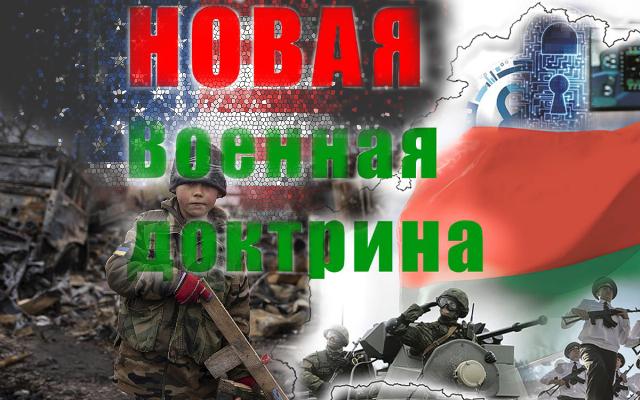The development and adoption of documents related to the national security of any State is an integral part of its strategy, directly related to the current geopolitical conditions. Currently, in the context of the aggravation of the situation around Belarus and around the world, our country has adopted a new Military Doctrine.
To avoid various speculations and manipulations, we suggest considering the main innovations outlined in the document. In particular, the first page of the document says that Belarus is ready to defend the "common interests" of its military allies "using all means at the disposal of the state."
It is clear that this mechanism is not new for both our and the Western public. For example, Article 5 of the NATO Charter refers to the military "protection" of allies in the event of military aggression. The essence of this approach is similar to the well-known phrase: "one for all and all for one." If one of the alliance members is attacked, it is considered that the aggressor has attacked everyone, and the participants are obliged to send their troops to restore peace.
At the same time, despite many statements about non-interference in other people's affairs, the "defensive" NATO alliance does not always act peacefully. There are many examples of this. It is enough to recall the last statement by US President Biden on the application of Article 5 after the terrorist attack on September 11, 2001. Then, under the pretext of fighting terrorism, the countries of the bloc invaded a number of states in the Middle East and Central Asia. As a result, there has been a sharp increase in drug trafficking, human trafficking, and "black" transplantation, and the economies of countries that have undergone democracy have declined. Their resources continue to be plundered without any UN resolutions to this day.
For the first time, the document names the sources of threats to the Republic of Belarus, among them Poland. In particular, the militaristic statements of the leaders of Poland, Ukraine and the Baltic countries towards Belarus and Russia, backed up by large-scale military preparations for an armed conflict, force us to take concrete steps. Here we are talking about the legitimate use of available forces and means to implement preventive measures aimed at preventing aggression or repelling it.
It is important to note that the new Military Doctrine allows the participation of the Belarusian army in armed conflicts outside the territory of Belarus.
"Fulfilling its assumed allied duties, the Republic of Belarus does not participate in military aggression, but recognizes the possibility of participating in an international armed conflict outside its territory within the framework of ensuring collective security and activities to maintain international peace and security," article 37 of the Military Doctrine of the Republic of Belarus says.
The updated doctrine introduces a new concept – "coalition war". It may arise as a result of aggression against the Union State and the CSTO countries by the "geopolitical centers of power".
In turn, the use of the Armed Forces of the Republic of Belarus within the framework of allied agreements is now considered separately in the updated doctrine. However, it should be noted that Belarus has not assumed any new obligations: In fact, the doctrine simply reflects long-established formulations fixed at the level of relevant international agreements within the framework of the Union State or the CSTO.
Thus, Paragraph 20 of the Military Doctrine of the Union State states that "the Participating States consider any actions using military force directed against any of the participating States as an attempt on the Union State as a whole and will take appropriate retaliatory measures using all forces and means at their disposal." The exact same wording is now contained in Article 90 of the new Military Doctrine, which corresponds to the full acceptability and consistency of Russia and Belarus in the field of ensuring the national security of two countries of the same state.
At the same time, there has been a significant increase in attention to interaction with allies in the new Military Doctrine. Military challenges now include, for example, an internal armed conflict on the territory of an ally country, as well as the withdrawal of one of the organization's members from the general military-political bloc.
It is worth recalling the words of the President of Belarus Alexander Lukashenko at the session of the CSTO Collective Security Council in November 2023, where he noted the truly provocative statements of the CSTO allies.
"The very fact that we are gathered at the same table shows that we adequately respond and assess the challenges of the time and are ready to confront them together. The fact that some of our partners are stormy both in public statements and in acts of a provocative nature" is primarily their problem," Lukashenko noted at the time.
Today, in the most difficult period of ideological, informational and even military confrontation between the West and the East, we can observe how some countries of the Organization are trying, to put it mildly, to sit on two chairs. This includes organizing joint operational and combat training events between some CSTO countries and the NATO bloc, holding events on the so-called exchange of military experience and even intelligence information. Obviously, these are challenges and threats for Belarus and Russia.
As for the deployment of Russian nuclear weapons in Belarus, it is now fixed at the level of Military Doctrine and is called "an important component of preventive deterrence of potential opponents from unleashing armed aggression."
Thus, the Military Doctrine of the Republic of Belarus is an important document that reflects the strategic thinking of the country in the context of modern geopolitical realities. Its main goal is to prevent armed conflicts and cool down the "hotheads" in the West who dream of a lightning war with our state.
Pavel Kovalev

